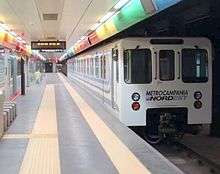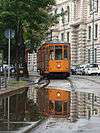Naples Metro
 | |
| Overview | |
|---|---|
| Native name | Metropolitana di Napoli |
| Locale | Naples, Campania, Italy |
| Transit type | Rapid transit |
| Number of lines | 3[1] |
| Number of stations | 26 |
| Annual ridership | 46,000,000 (2013)[2][3] |
| Website | ANM |
| Operation | |
| Began operation | 28 March 1993[4] |
| Operator(s) | Azienda Napoletana Mobilità s.p.a. (ANM) |
| Technical | |
| System length | 20.2 km (12.6 mi)[1] |
The Naples Metro (Italian: Metropolitana di Napoli) is the metro system serving the city of Naples, Italy. The system includes three underground rapid transit lines (Line 1, Line 6 and the Naples-Aversa Metro).
History
In 1911 construction on the urban section of the Rome–Formia–Naples railway, the Villa Literno–Napoli Gianturco railway was commenced, and although it was suspended for the duration of World War I, the line was eventually opened on 28 September 1925 as an urban railway service line, the first in Italy.[5] This service is now known as Line 2.
After the World War II, the existing Circumvesuviana railway was upgraded to a modern commuter rail, and also the Cumana railway became relevant for the commuter transport. In 1962 the Circumflegrea railway was opened.[6]
Construction of the first underground metro railway (Line 1) began in 1986, and the first part opened on 28 March 1993.[7] Initially called the Metropolitana Collinare ("Hills metro") it ran for 4 km (2.5 mi) between Colli Aminei and Vanvitelli.[4] Two years later, in 1995, the line was extended to reach Piscinola[4] giving an overall track length of 8 kilometres (5.0 mi).[8]
Although progress had been made from the early setbacks and problems, it was still apparent by 1997 that the network suffered badly from the lack of network integration and poor connections, as well as the fact that large areas of Naples were not close to stations. In 1997 the city government drew up a new Piano Comunale dei Trasporti di Napoli (City Transport Plan) which called for a review of the network, improved controls over maintenance expenditure and general finances, a new tariff control system and better management of the urban rail network of Naples.[9]
The transport plan called for a three phase major redevelopment. Phase 1 would involve an expansion to a total of five lines, including major redevelopment of Line 1, and take the network up to 53 km of track (45 km of existing lines), with 68 stations (23 newly built), and 12 interchange nodes, to be completed by 2001. Phase 2 was designed to increase the network to 7 lines, with 84 stations, and 16 interchange nodes, plus 10 bus interchanges, to be completed by 2007. Phase 3 would see the network expanded to 10 rail lines with 93 km of track, and a further 30 km of new light rail (tram lines) linking 114 stations, with 21 interchanges, and 24 bus interchanges to be completed by 2011. The plan called for 70% of Neapolitans to be living within 500 metres of a transport access point by 2011.[8]
In conjunction with the regional government of Campania, the comune government of Naples incorporated a new fully state-controlled joint-stock corporation called Metronapoli, which was 99% controlled by the comune and 1% controlled by ANM (Azienda Napoletana Mobilità), with a mission statement of: "providing an efficient public rail transport service of quality to the city".
In 2000, a new line, Line 9, was proposed. Intended to connect the National Archaeological Museum via the Museo di Capodimonte, providing an alternative route to part of Line 1, the project was abandoned.
Metronapoli took over responsibility for running the urban rail transport network of Naples as part of a planned massive re-invigoration of public transport in the Campania region, on 1 February 2001. The regional government announced a rivoluzione del ferro (rail revolution) which involved a planned expansion of the region's network at a cost of €3.8 billion euros, and would see the construction of 1,400 km of new tracks and 80 new stations for a total of 423 stations on the network within Campania.
On 14 April 2001, service on Line 1 was extended from Vanvitelli to Museum (Museo) station.[4]
In 2005 The Naples-Aversa Metro line opened between Piscinola and Mugnano.
On 3 December 2005, the CIPE, (Interdepartmental Committee for Economic Planning) announced over €600 million worth of funding to be spent the Metropolitana di Napoli network. €323 million was allocated for Montesanto station (Cumana and Circumflegrea), €61.1 million for Quattro Giornate station (Line 1 and Circumflegrea), with both projects to be completed by 2010, as well as €119.7 million to be spent to improve the section of Line 1 between Capodichino and Centro Direzionale and €100 million for the San Pasquale–Municipio section.[10]
From 23 December 2006 to 20 February 2007 a special exhibition of models and multimedia presentations was held at Castel dell'Ovo to showcase all of the planned improvements to the Metropolitana di Napoli network, and was extremely well received by Neapolitans.
Line 6, which is categorized as a "light metro" line, opened in February 2007, running on 2.3 kilometres (1.4 mi) of route and serving 4 stations.[11]
In 2009 the Naples-Aversa Metro extended to Aversa Centro.
On 28 March 2011, Line 1 was extended from Museo station to Università.
On 17 September 2012, the Toledo station between Dante and Università opened on Line 1.[4]
On 31 december 2013, Line 1 was extended to Garibaldi right next to the central train station.
On 2 June 2015 the station Municipio (Town Hall) was opened between Università and Garibaldi on Line 1.
Operator
Azienda Napoletana Mobilità SpA is currently responsible for the transport services and maintenance of Line 1, Line 6, pedestrian subways, and the funicular railways (Chiaia, Mergellina and Montesanto).
Network
The Naples Metro currently operates on three lines.
| Line | Opened | Length | Stations | Average weekday ridership |
Ridership per annum (millions) |
|---|---|---|---|---|---|
| Line 1 | 1993[4] | 18 km (11 mi)[1] | 18[12] | 135,000[13] | 34.675 |
| Line 6 | 2007[13] | 2.2 km (1.4 mi)[1] | 4[13] | ||
| Naples-Aversa Metro | 2005[13] |
Rolling stock
 Line 1
Line 1 Line 6
Line 6 Naples-Aversa Metro
Naples-Aversa Metro
Travelling
Fares
UNICO NAPOLI is the integrated fare that allows to travel on all means of transport of Consortium companies in Naples. There are different kinds of tickets and passes: hourly, daily or weekend daily ticket, monthly or annual pass. The hourly ticket is Valid for 90 minutes from the first validation, while the daily ticket is valid from 00.00 to midnight of the day of validation. The owner must fill in the appropriate blanks with their name and date of birth, and must show an ID when requested.
Operations
Trains operate from 6:00 to 23:00 every day of the year. Headways on Line 1 are generally between 10–14 minutes,[14] but reach a maximum of 8 minutes during weekday peak hours.[13] Commercial speeds on Line 1 are 32 km/h (20 mph).[13]
Line 6 is currently closed to the public.[14]
Artwork
Line 1 has been renamed 'Il Metrò dell'Arte' (The Art Metro) reflecting the fact that eight stations have been upgraded to exhibit works of art. These include both permanent exhibits and the provision for temporary displays. It is intended that this theme will continue as more of the planned stations on Line 1 are opened.
Museum station (stazione Museo) also displays archaeological remains and exhibits that were unearthed during the construction of the station, while others have been transferred to the Museo Archeologico Nazionale di Napoli (Naples National Archaeological Museum) above the station, from which it is named.[15]
Another initiative recently started on the Metropolitana di Napoli was to provide free books for riders on the network.[16]
See also
- List of Naples Metro stations
- Line 2 (Naples) (commuter rail line)
- Circumvesuviana
- Circumflegrea railway
- Cumana railway
- Naples–Aversa railway
- Trams in Naples
- List of metro systems
- Lists of rapid transit systems
References
- 1 2 3 4 "anm in cifre" [anm in figures] (in Italian). Azienda Napoletana Mobilità s.p.a. (ANM). Retrieved 2015-06-19.
- ↑ http://www.anm.it/index.php?option=com_content&task=view&id=1620&Itemid=198
- ↑ Including 4 funicular railways
- 1 2 3 4 5 6 "HOME - Press Kit - Press Kit - Linea 1 - Storia della Linea 1 metropolitana di Napoli" [HOME - Press Kit - Press Kit - Line 1 - History of Naples Metro Line 1] (in Italian). Metronapoli SpA. Retrieved 2013-11-13.
- ↑ Giovanni Cornolò (2011). Automotrici elettriche. Dalle origini al 1983. Duegi Editrice. p. 28. ISBN 88-95096-05-3.
- ↑ L. Munzi: Nuovi treni SEPSA. In: ″Italmodel Ferrovie″ Nr. 220 (November 1978), p. 765.
- ↑ Metropolitana di Napoli. In: ″I Treni Oggi″ Nr. 137 (May 1993), p. 8.
- 1 2 Robert Schwandl. "Napoli". UrbanRail.net. Retrieved 2015-06-19.
- ↑ David Briginshaw (1999). "Signs Of Progress In Naples And Turin - Brief Article". International Railway Journal. Retrieved 2008-10-02.
- ↑ "Trasporti su ferro, dal Cipe l'ok ai progetti della Regione". Il Mattino. 3 December 2005.
- ↑ "HOME - Press Kit - Press Kit - Linea 6 - Con Linea 6 il sistema Metronapoli avanza" [HOME - Press Kit - Press Kit - Line 6 - With Line 6, the system advances Metronapoli] (in Italian). Metronapoli SpA. Retrieved 2013-11-13.
- ↑ "metro" (in Italian). Azienda Napoletana Mobilità s.p.a. (ANM). Retrieved 2015-06-19.
Serve complessivamente 17 stazioni su un percorso di 18 km di rete, raggiungendo in alcuni punti una pendenza del 5,5%. ([Line 1] serves a total of 17 stations over a distance of 18 km network, reaching in places a slope of 5.5%.)
Including Municipio station that opened in June 2015, there are now 18 stations on Line 1. - 1 2 3 4 5 6 "metro" (in Italian). Azienda Napoletana Mobilità s.p.a. (ANM). Retrieved 2015-06-19.
- 1 2 "Frequenze def" [Final frequencies] (PDF) (in Italian). Azienda Napoletana Mobilità s.p.a. (ANM). Retrieved 2015-06-19.
- ↑ "Naples Metro". Metrobits.org. 25 September 2008.
- ↑ "Libri gratis in Metropolitana Linea 1". Napolibella. 2 November 2008.
External links
![]() Media related to Naples metro at Wikimedia Commons
Media related to Naples metro at Wikimedia Commons
- ANM – official website (Italian)
